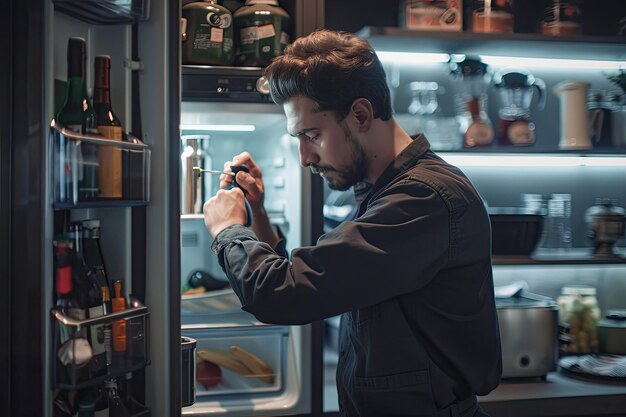Mastering Ice Making with Your Whirlpool Refrigerator: A Comprehensive Guide
Imagine having a refreshing cold drink at your fingertips whenever you want it, thanks to the efficient ice-making capabilities of your Whirlpool refrigerator. This guide dives deep into understanding how to make ice in your Whirlpool refrigerator, providing practical insights, guidance, and solutions to ensure you're getting the most out of your appliance's functionality.
Discovering Your Whirlpool Ice Maker
Understanding the Components
Before you embark on the journey of creating the perfect ice cubes, it's essential to familiarize yourself with the components of your Whirlpool ice maker. At its core, the ice maker consists of an ice mold, an electronic control module, a motor that moves ice from the mold to the bin, and a water supply valve. Each part plays a significant role in the ice-making process.
Initial Setup and Activation
Ensuring your ice maker is correctly set up is crucial. When setting up your Whirlpool refrigerator, ensure that the water supply line is securely connected. This line is responsible for delivering water to the ice maker. Afterward, turn on the ice maker by locating the switch, typically on the side or front of the ice maker unit inside the freezer.
Key Tip: Once you activate the ice maker, it might take a few hours to start producing ice, as the system regulates the temperature and cycles through initial water fills.
Steps to Efficient Ice Production
Adjusting Temperature Settings
To achieve optimal ice production, you need to maintain suitable interior temperatures. Whirlpool recommends setting the freezer temperature to 0°F (-18°C) for the best ice production. An excessively warm freezer will cause slow ice production, while very low temperatures might result in excess frost.
Checking Water Supply and Filter
A consistent water supply is vital for your ice maker's proper functionality. Regularly check the water filter and replace it every six months to ensure clean water flow. A clogged filter can significantly reduce water pressure, impeding ice production.
Changing the Water Filter:
- Locate the filter compartment.
- Turn the old filter counterclockwise to remove it.
- Insert the new filter and turn it clockwise until it locks in place.
Monitoring Ice Maker Functionality
Modern Whirlpool refrigerators often come with indicator lights to notify you if the ice maker needs attention. These might signal issues such as the ice maker being turned off, a full ice bin, or a needed filter replacement. Always make sure the ice bin is not overfilled, as it might trigger a stop in ice production.
Troubleshooting Common Issues
Ice Maker Not Producing Ice
If your ice maker isn't producing ice, consider these troubleshooting steps:
- Check the Power: Make sure the ice maker is plugged in and the switch is on.
- Inspect Water Line: Ensure there are no kinks or blockages in the water line.
- Examine Temperature Settings: Confirm that the freezer’s temperature is set to 0°F (-18°C).
Slow Ice Production
For slow ice production, verify that the water pressure is adequate. Low water pressure could hinder the ice-making cycle. Additionally, make sure the water filter is not clogged and replace it if necessary.
Poor Ice Quality
If the ice cubes are cloudy or taste off, it might be time to clean the ice maker. Residue or minerals in the system can lead to poor quality. Use a mixture of vinegar and water to clean the ice maker periodically.
Enhancing Your Ice-Making Experience
Leveraging Ice Maker Features
Whirlpool refrigerators often come equipped with advanced features to improve convenience:
- Fast Ice Option: Use this feature to temporarily increase ice production when you need extra ice, such as during parties or gatherings.
- Ice Cube Size Adjustments: Some models allow you to adjust the size of the ice cubes by changing the water fill level.
Maintaining a Clean Machine
Regular maintenance ensures longevity and efficient operation. Here’s a clean-up routine you can follow:
- Bi-Annual Deep Clean: Every six months, clean the ice maker and bin with a mild cleaning solution to prevent build-up.
- Monthly Quick Clean: Wipe down the exterior and interior surfaces with a damp cloth.
Energy Efficiency Considerations
Energy efficiency is a notable feature of Whirlpool appliances. To maximize this, ensure the refrigerator doors seal tightly and are closed promptly after each opening. This practice maintains the internal temperature, aiding ice production efficiency.
Visual Summary of Ice Maker Tips
🧊 Ice Making Key Tips:
- 🔌 Ensure Power: Make sure the ice maker is plugged in and activated.
- 🌡️ Optimal Temps: Set your freezer to 0°F (-18°C) for best results.
- 🚰 Check Water Supply: Ensure an uninterrupted and clean water flow.
- 🧽 Regular Cleaning: Clean your ice maker bi-annually and replace water filters every six months for the best quality ice.
- ⚡ Enhance Efficiency: Utilize energy-efficient practices like checking door seals regularly.
Concluding Insights
Navigating the art of making perfect ice with your Whirlpool refrigerator is simpler once you understand the mechanisms and how to maintain them. This guide empowers you with knowledge and practical steps to ensure a continuous supply of fresh, quality ice. By investing a little time in understanding your appliance and maintaining it regularly, you can enjoy seamless and efficient ice production for years to come. Enjoy the luxury of never having to worry about running out of ice again!
